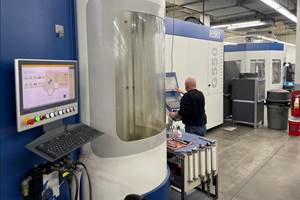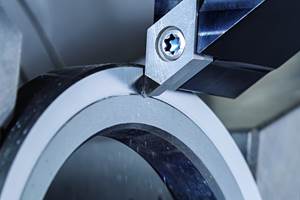Supercritical Success for Medical Machining
High-pressure carbon dioxide coolant can dramatically improve the production rate of titanium parts while leaving no residue — an excellent fit for medical machining.
Share





For the vast majority of machining applications, liquid coolants are the preferred method of preventing heat damage in both workpieces and cutting tools. However, many industries have rigorous standards for part cleaning that makes both oil- and water-based coolants less attractive, and some workpieces must be machined dry to avoid contamination from the coolants. According to Erik Poulsen, Medical Market Segment Manager for GF Machining, one alternative medical manufacturers should look at is supercritical carbon dioxide (supercritical CO2).
Lubrication without Residue
The first question I had when I spoke to Poulsen was simple: What does supercritical mean? “Supercritical refers to a state when a substance is at such an extreme pressure that there ceases to be a difference between the substance’s liquid and solid phases,” Poulsen says. “It behaves like a liquid and like a gas simultaneously.”
Keeping the coolant pressure at 1,500 psi often necessitates customizing machine tools to use supercritical CO2. GF Machining is currently developing a version of its Mikron Mill S three-axis machining center that provides a turnkey through-coolant system compatible with supercritical CO2, but the system is not yet available.
Source: GF Machining
For carbon dioxide, the supercritical phase is at around 1,500 psi and 25.6 degrees Celsius (78 degrees Fahrenheit). “Once it’s released, it rapidly evaporates and cools to about -70 degrees Celsius,” Poulsen explains. These properties have supercritical CO2 seeing widespread use in cleaning electronics, as water can damage the final product. However, its machining applications — sometimes referred to as cryogenic machining — are less widely known.
When used in machining, tiny amounts of oil get injected into the supercritical CO2 fluid, dispersing evenly. “This creates miniature spheres of oil throughout the fluid that dramatically improve cutting conditions,” Poulsen says, explaining that the oil evaporates along with the carbon dioxide. This is called minimum quantity of lubrication (MQL), and its benefits are more clearly seen in difficult materials like titanium.
“Titanium is one of the materials where we see the greatest success [with supercritical CO2],” Poulsen says. Machining titanium generates a lot of heat, and managing that heat is key to successful part production, something supercritical CO2 can handle better than many options. “In our tests machining titanium, using supercritical CO2 with an MQL additive doubles the material removal rate and doubles the life of the cutting tool.” That material removal rate translates to a 30-40% decrease in production time, according to Poulsen.
While that decrease in production time is enticing on its own, this process also delivers energy savings. “Machining something in 30% less time reduces energy consumption per part by roughly 30%,” Poulsen explains. “But there’s even more energy savings because you can the energy use of flood coolant pumps, increasing total energy savings to around 45%.”
One field that may be particularly interested in these benefits is medical machining, both because titanium is a common material in medical implants and because eliminating coolant residue it much easier to prevent contamination in the final product.
Under Pressure
Some readers may have already guessed one of the major drawbacks of supercritical CO2: 1,500 psi is a lot of pressure, enough to damage machines not specially designed for this process. Additionally, it often uses through-spindle coolant, which means using through-coolant cutting tools and equipping the spindle with a rotary union capable of handling 1,500 psi and speeds up to 30,000 rpm.
GF Machining, however, has been developing a turnkey solution with through-coolant systems capable of handling the intense pressures. “GF is the only milling machine provider developing a machine with supercritical CO2 fully integrated, so you don’t have to take the risk of developing the process yourself,” Poulsen says. “We know how to do it, and we can put it together for you.”
The company has also tested the process with a number of different cutting tools, finding that a variety of milling tools can benefit from the process. “We’ve done tests down to tool diameters of 1 millimeter, and it holds and cools,” Poulsen says. “It doesn’t get the same bump in tool life and speed, but it still eliminates flood coolant.”
While a turnkey solution for machining with supercritical CO2 coolant may not be available today, the technology exists, and machine shops plugged into the medical manufacturing industry may want to keep it in mind as they plan future work.
Related Content
Five-Axis Turnkey Machine Halves Medical Shop’s Cycle Times
Horizontal five-axis machines cut cycle times in half at ARCH Medical Solutions – Newtown. But its leadership gives equal credit to a surprising factor: the OEM’s service department.
Read MoreTungaloy-NTK PCD Grade Optimizes Dimensional Accuracy
The DX200 is an effective tool for machining application-specific components that demand high levels of material purity, such as metal medical implants and sputtering targets for semiconductor applications.
Read MoreForkardt Hardinge Swiss Workholding Provides Reliable, Consistent Performance
The company’s Swiss collets are designed to securely hold parts without marring surfaces, minimizing vibration to ensure smoother machining, enhanced accuracy and extended tool life.
Read MoreGerman Project Yields Three New Medical Machining Processes
Trends to Watch at IMTS: Recent research has resulted in a new mix of high-speed turn whirl milling, polygon turning and rotational turning for manufacturing medical bone screws and out-of-round nails.
Read MoreRead Next
Machine Shop MBA
Making Chips and 91ÊÓƵÍøÕ¾ÎÛ are teaming up for a new podcast series called Machine Shop MBA—designed to help manufacturers measure their success against the industry’s best. Through the lens of the Top Shops benchmarking program, the series explores the KPIs that set high-performing shops apart, from machine utilization and first-pass yield to employee engagement and revenue per employee.
Read MoreAMRs Are Moving Into Manufacturing: 4 Considerations for Implementation
AMRs can provide a flexible, easy-to-use automation platform so long as manufacturers choose a suitable task and prepare their facilities.
Read MoreLast Chance! 2025 Top Shops Benchmarking Survey Still Open Through April 30
Don’t miss out! 91ÊÓƵÍøÕ¾ÎÛ's Top Shops Benchmarking Survey is still open — but not for long. This is your last chance to a receive free, customized benchmarking report that includes actionable feedback across several shopfloor and business metrics.
Read More























